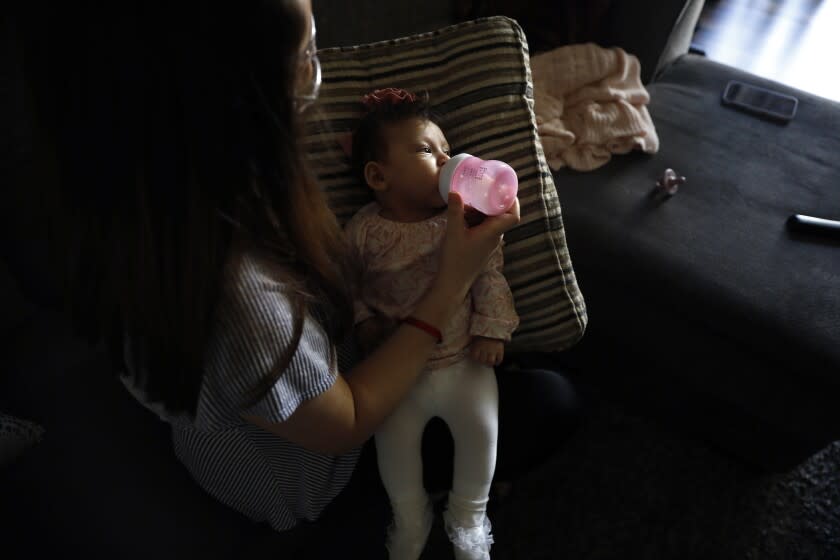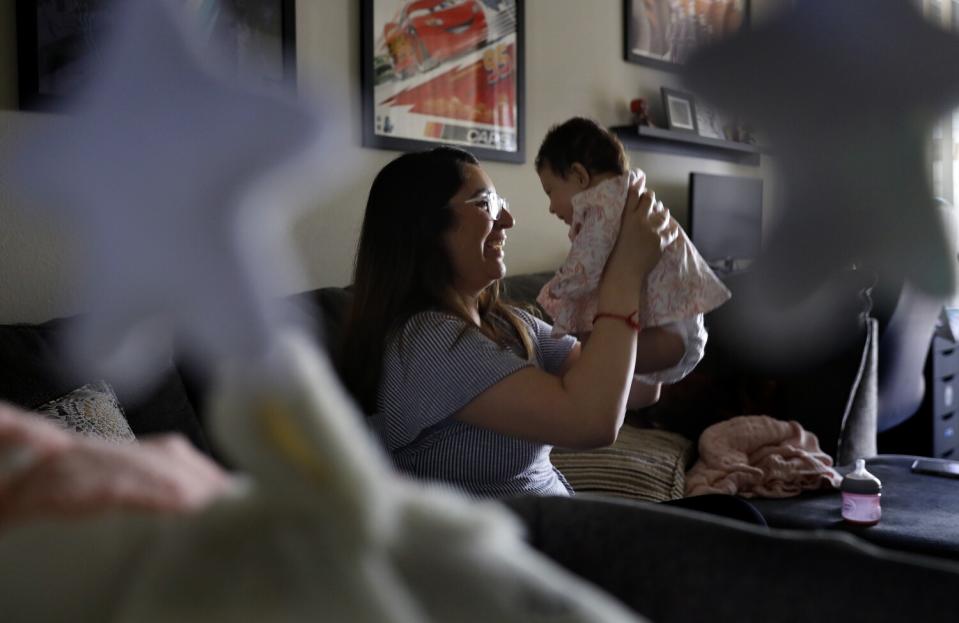As baby formula shortage worsens, families take desperate steps

Like most new moms, 26-year-old Veronica Gutierrez sees her life revolve around feeding her 3-month-old daughter, Alessandra.
For the first month, that meant mostly formula. But that formula was hard to find. She drove from store to store, so shaken by the empty shelves that she began pumping breast milk around the clock, in hopes she could draw out enough to feed Alessandra full time.
"I had just gotten home from the hospital, and I was in so much pain — even just having to jump in the car trying to find the formula, I was almost in tears," Gutierrez said.
"There was that uncertainty whether I was actually going to find the formula,” she said. “That's why I was working every day latching her on, even if she got just a little bit, because I knew if I didn't, I would lose my milk supply."
All night, Alessandra nurses. All day, Gutierrez pumps. Still, she considers herself lucky. Unlike millions of American parents, she's no longer worried about where her baby's next meal will come from.
Transitioning a bottle-fed baby back to breast milk is a Herculean task. But it's far from the most extreme measure desperate mothers have taken amid the worsening national shortage of formula.
"Families are having to water down formula or use [cow's] milk when they’re not ready to," said Kelly Sawyer Patricof of Baby2Baby, an L.A.-based nonprofit that distributes formula and other supplies to needy families. "They also use juice as a replacement or transition to solid foods before their babies are developmentally ready."
The crisis has been deepening for months, as millions of parents scramble to feed their children. But low-income mothers such as Gutierrez have been hit particularly hard. About half of all infant formula sold in the United States is purchased through the Special Supplemental Nutrition Program for Women, Infants and Children, or WIC, which pays for food for pregnant people and children under 5 living in or near poverty.
While all kinds of babies get formula for all kinds of reasons, WIC recipients such as Alessandra get it at roughly double the rate of their wealthier neighbors. In South L.A., more than 70% of babies Alessandra's age are formula-fed; on the Westside, roughly the same proportion receive only breast milk. Across California, about 150,000 infants receive formula through the program.
Now, many mothers say they're struggling to find it.
"Today was my ninth store, and I actually got something," said Jocelyn Landers, a nurse in Harbor City who buys formula for her 2-month-old daughter, Alaya, under WIC. "I was grateful to even get a can to hold her over. I don't understand how we got to this point."

The shortage began late last year, months before Alaya or Alessandra were born. At the time, many formula ingredients were caught in the disrupted supply chain, alongside infant strollers, car seats and cribs.
But the shortage grew more dire in February, after two babies died and two others were hospitalized with Cronobacter infections linked to formula from an Abbott Laboratories plant in Sturgis, Mich.
Abbott makes more than 40% of the baby formula sold in the United States, mostly under the brand Similac. It is also the primary supplier for WIC programs in many states, including Louisiana, Washington and Texas.
The infections touched off a wave of recalls, mostly of specialty formulas used by medically fragile babies and children. Worse, the plant — the largest manufacturing facility for the largest formula supplier in the country — was shuttered.
"With the combination of all these production issues and the recall, there's a significant shortage on all ends," said Nicole Meadow, a clinical dietitian in the Heart Institute at Children's Hospital Los Angeles. "Several times a day I'm sending cases of formula to a family, just to help with the gaps."
California's WIC program is contracted with Mead Johnson, the maker of Enfamil, which controls most of the rest of the market. But there, too, supply chain issues persist.
Earlier this week, the glassed-in shelves of formula at a Target store in Compton were picked almost bare. Online, the retailer was no longer listing the products covered by WIC, nor almost any other formula.
As Similac has dried up, parents with means have sought out alternatives. Millions choose formula because they can't nurse or don't want to, because their infants are adopted or born through surrogacy or because they've struggled to produce enough milk. Some are now buying formula from abroad, while others have switched to pricier boutique brands.
Parents of children with allergies or complex medical needs have enlisted doctors, pharmacists and extended family networks to source the specialized formula they need.
"It was like, all of a sudden, we couldn't find anything," said Agoura mom Gillian Mahar, whose 9-month-old twins need hypoallergenic formula. "My husband and I probably went to 50 stores within a 20-mile radius. We had family members who were driving from Phoenix to L.A., stopping in every Target and grocery store on the way, trying to find it."
Many others have simply switched to Enfamil. Increasingly, they reach for the 12.4-ounce cans, the only size paid for by WIC.
"I’ve gone to stores in Long Beach, I've gone to Rolling Hills, Carson — I've gone to Inglewood just to see if I could get lucky," said Landers. "If they do have it, it’s the larger size; it’s not the size that's approved."
That means the low-income mom is either out of luck or has to pay for the pricey formula herself. She cannot afford it.
On Thursday, President Biden urged states to loosen restrictions on the brand, type and size of formula that families can buy through the program. But even with those constraints lifted, WIC mothers have fewer options than many other parents, because eligible families are disproportionately likely to use formula in the first place and to live in neighborhoods with others competing for the same six types of Enfamil powder.
"Return to work is a big barrier for continued breastfeeding when you're lower income," said Dr. Shannon Whaley, director of research and evaluation at PHFE WIC, which serves Southern California.
That's because many WIC-eligible mothers don't qualify for California's paid family leave program or can't afford to take it, she and other experts said. They're also less likely to work from home, or to have protected time or space to pump and store breast milk.
"If you ask a mom why they've chosen formula, in a lot of instances they will tell you why they can't breastfeed," said Cindy Clapp, deputy director of PHFE WIC's breastfeeding department. "We have amazing high-end pumps to loan to our participants, but if the mom isn’t in an environment that allows her to use [it], it makes no difference."
Whaley was more blunt.
"If you’re working at Taco Bell, where are you going to pump?" she said.

Nevertheless, until recently, the WIC's breastfeeding numbers had been trending up. Participants such as Gutierrez work closely with certified lactation consultants and have access to hospital-grade breast pumps. Additionally, lactating parents are allotted more food than those who opt to give their babies formula, since producing breast milk requires up to 500 extra calories a day.
Still, "the rates went down [significantly] during the pandemic, and we can’t tell really why," said Dr. Maria Koleilat, an assistant professor in the health science department at Cal State Fullerton. "The rates went down not only at WIC, but everywhere I looked."
Meanwhile, there's evidence the shortage of formula could get worse before it gets better.
Abbott has announced that it can resume production at the Sturgis plant two weeks after the Food and Drug Administration clears it for a reopening, which is expected imminently. From that point, the company said, it will take six to eight weeks before formula from the plant is available in stores.
Other manufacturers have been recruited to try to fill the gap. According to the White House, "more infant formula has been produced in the last four weeks than in the four weeks preceding the recall."
But Gutierrez, Alessandra’s mom, isn't taking any chances. She recently requested unpaid leave from the assisted living facility where she works so she can continue to pump every three hours during the day, in an effort to protect her milk supply.
"I was actually supposed to start back the 29th of last month, but I requested an extension," she said. "Hopefully my job is still secure."
For Landers, Alaya’s mom, there's little to do but watch and wait. California WIC will switch from Enfamil to Similac on Aug. 1 — less than a week past the earliest date Abbott has said it could have its products back on shelves.
"I just want to stick with what works, but WIC said they're switching to Similac," the worried mom said. "It makes me so anxious. How am I going to feed her if this doesn't get fixed?"
This story originally appeared in Los Angeles Times.

